See you not that Allâh drives the clouds gently means that God drives and pushes the clouds easily and gently, then joins them together, He collects a cloud with another, then makes them into a heap of layers means cumulus clouds over each other, and you see the rain comes forth from between them, you see the rain coming out of them, and He sends down from the sky hail (like) mountains means that they are wonderful pieces like mountains.
The Scientific Fact:
Scientists
have recently made dazzling discoveries about the formation of hail in
the clouds and noticed that the first thing formed is the cloud that is
pushed by the wind till it meets another cloud, and that's how the
clouds are collected over each other by the air currents called pushing
streams until they form the cumulus clouds.
Then,
when the cumulus clouds rise up for several kilometers, the hailstones
begin to be formed and then by air currents they start to fall on the
ground, while some of them stay in the clouds and others melt before
reaching the ground. Scientists say that the hail is always accompanied
by lightning flashes.
The Point of Inimitability:
We
notice from these facts that the holy Quran corresponds with modern
science in its sayings about the formation of hail and the role of wind
in the formation of cumulus clouds and that the lightning is formed in
the clouds that contain the hailstones. Scientists say that the hail is
formed only in the high cumulus clouds, therefore God be he exalted
says: (and
He sends down from the sky hail (like) mountains, (or there are in the
heaven mountains of hail from where He sends down hail).
And this is from the inimitability of Quran, so who could have known at
that time these detailed information if Muhammad wasn't a messenger
from God!
Scientists have studied cloud types and have
realized that rain clouds are formed and shaped according to definite systems
and certain steps connected with certain types of wind and clouds.
One kind of rain cloud is the cumulonimbus
cloud. Meteorologists have studied how cumulonimbus clouds are formed and
how they produce rain, hail, and lightning.
They have found that cumulonimbus clouds go
through the following steps to produce rain:
1) The clouds are pushed by the wind:
Cumulonimbus clouds begin to form when wind pushes some small pieces of clouds
(cumulus clouds) to an area where these clouds converge (see figures 17 and 18).
Figure 17: Satellite photo
showing the clouds moving towards the convergence areas B, C, and D.
The arrows indicate the directions of the wind. (The Use of Satellite
Pictures in Weather Analysis and Forecasting, Anderson and others, p.
188.) (Click on the image to enlarge it.)
|
Figure 18: Small pieces of clouds
(cumulus clouds) moving towards a convergence zone near the horizon, where
we can see a large cumulonimbus cloud. (Clouds and Storms, Ludlam,
plate 7.4.) (Click on the image to enlarge it.)
|
2) Joining: Then the small clouds
join together forming a larger cloud1
(see figures 18 and 19).
Figure 19: (A) Isolated small pieces
of clouds (cumulus clouds). (B) When the small clouds join
together, updrafts within the larger cloud increase, so the cloud is
stacked up. Water drops are indicated by ·.
(The Atmosphere, Anthes and others, p. 269.) (Click on the
image to enlarge it.)
|
3) Stacking: When the small clouds
join together, updrafts within the larger cloud increase. The updrafts
near the center of the cloud are stronger than those near the edges.2
These updrafts cause the cloud body to grow vertically, so the cloud is stacked
up (see figures 19 (B), 20, and 21). This vertical growth causes the cloud
body to stretch into cooler regions of the atmosphere, where drops of water and
hail formulate and begin to grow larger and larger. When these drops of
water and hail become too heavy for the updrafts to support them, they begin to
fall from the cloud as rain, hail, etc.3
Figure 20: A cumulonimbus cloud. After the
cloud is stacked up, rain comes out of it. (Weather and Climate,
Bodin, p.123.)
|
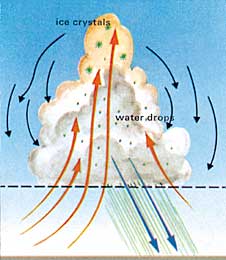 |
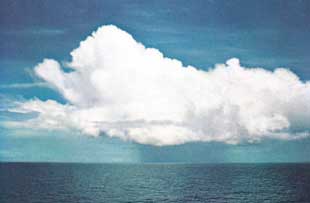 |
Figure 21: A cumulonimbus cloud. (A
Colour Guide to Clouds, Scorer and Wexler, p. 23.)
|
God has said in the Quran:
Meteorologists have only recently come to know
these details of cloud formation, structure, and function by using advanced
equipment like planes, satellites, computers, balloons, and other equipment, to
study wind and its direction, to measure humidity and its variations, and to
determine the levels and variations of atmospheric pressure.4
The preceding verse, after mentioning clouds and
rain, speaks about hail and lightning:
Meteorologists have found that these cumulonimbus
clouds, that shower hail, reach a height of 25,000 to 30,000 ft (4.7 to 5.7
miles),5 like mountains, as the Quran
said, “...And He sends down hail from mountains (clouds) in the sky...”
(see figure 21 above).
This verse may raise a question. Why does
the verse say “its lightning” in a reference to the hail? Does this
mean that hail is the major factor in producing lightning? Let us see what
the book entitled Meteorology Today says about this. It says that a
cloud becomes electrified as hail falls through a region in the cloud of
supercooled droplets and ice crystals. 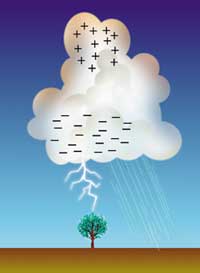 As liquid droplets collide with a
hailstone, they freeze on contact and release latent heat. This keeps the
surface of the hailstone warmer than that of the surrounding ice crystals.
When the hailstone comes in contact with an ice crystal, an important phenomenon
occurs: electrons flow from the colder object toward the warmer object.
Hence, the hailstone becomes negatively charged. The same effect occurs
when supercooled droplets come in contact with a hailstone and tiny splinters of
positively charged ice break off. These lighter positively charged
particles are then carried to the upper part of the cloud by updrafts. The
hail, left with a negative charge, falls towards the bottom of the cloud, thus
the lower part of the cloud becomes negatively charged. These negative
charges are then discharged as lightning.6
We conclude from this that hail is the major factor in producing lightning.
As liquid droplets collide with a
hailstone, they freeze on contact and release latent heat. This keeps the
surface of the hailstone warmer than that of the surrounding ice crystals.
When the hailstone comes in contact with an ice crystal, an important phenomenon
occurs: electrons flow from the colder object toward the warmer object.
Hence, the hailstone becomes negatively charged. The same effect occurs
when supercooled droplets come in contact with a hailstone and tiny splinters of
positively charged ice break off. These lighter positively charged
particles are then carried to the upper part of the cloud by updrafts. The
hail, left with a negative charge, falls towards the bottom of the cloud, thus
the lower part of the cloud becomes negatively charged. These negative
charges are then discharged as lightning.6
We conclude from this that hail is the major factor in producing lightning.
 As liquid droplets collide with a
hailstone, they freeze on contact and release latent heat. This keeps the
surface of the hailstone warmer than that of the surrounding ice crystals.
When the hailstone comes in contact with an ice crystal, an important phenomenon
occurs: electrons flow from the colder object toward the warmer object.
Hence, the hailstone becomes negatively charged. The same effect occurs
when supercooled droplets come in contact with a hailstone and tiny splinters of
positively charged ice break off. These lighter positively charged
particles are then carried to the upper part of the cloud by updrafts. The
hail, left with a negative charge, falls towards the bottom of the cloud, thus
the lower part of the cloud becomes negatively charged. These negative
charges are then discharged as lightning.6
We conclude from this that hail is the major factor in producing lightning.
As liquid droplets collide with a
hailstone, they freeze on contact and release latent heat. This keeps the
surface of the hailstone warmer than that of the surrounding ice crystals.
When the hailstone comes in contact with an ice crystal, an important phenomenon
occurs: electrons flow from the colder object toward the warmer object.
Hence, the hailstone becomes negatively charged. The same effect occurs
when supercooled droplets come in contact with a hailstone and tiny splinters of
positively charged ice break off. These lighter positively charged
particles are then carried to the upper part of the cloud by updrafts. The
hail, left with a negative charge, falls towards the bottom of the cloud, thus
the lower part of the cloud becomes negatively charged. These negative
charges are then discharged as lightning.6
We conclude from this that hail is the major factor in producing lightning.
This information on lightning was discovered
recently. Until 1600 AD, Aristotle’s ideas on meteorology were
dominant. For example, he said that the atmosphere contains two kinds of
exhalation, moist and dry. He also said that thunder is the sound of the
collision of the dry exhalation with the neighboring clouds, and lightning is
the inflaming and burning of the dry exhalation with a thin and faint fire.7
These are some of the ideas on meteorology that were dominant at the time of the
Quran’s revelation, fourteen centuries ago.
The Quran is not claiming hail comes from mountains !! Once again the deceivers are taking us for fools if they believe people in 7th century Arabia thought hail came from mountains, surely Arabians who did live next to mountains could tell this by simple observation. Well, according to the liars, they could not. The sceptics are being foolish and amateur.
Actually the verse confirms that hail comes from the sky as it states “ He sends down FROM THE SKY hail” . This scuppers and disproves the sceptics claim. Were they unable to comprehend a simple English translation of the meanings of Quran.
As for the “mountains” reference, it clearly refers to the initial clouds holding the hail. Hail is a result of suspended ice in the air and hail forms in cumulonimbus clouds (which are like mountains). So the Quran is super accurate and seems to bring forward something people could view as a scientific miracle!
Footnotes:
(1) See The Atmosphere,
Anthes and others, pp. 268-269, and Elements of Meteorology, Miller and
Thompson, p. 141. 
(2) The updrafts near the
center are stronger, because they are protected from the cooling effects by the
outer portion of the cloud. 
(3) See The Atmosphere,
Anthes and others, p. 269, and Elements of Meteorology, Miller and
Thompson, pp. 141-142. 
(4) See Ee’jaz al-Quran
al-Kareem fee Wasf Anwa’ al-Riyah, al-Sohob, al-Matar, Makky and others,
p. 55. 
(5) Elements of
Meteorology, Miller and Thompson, p. 141. 
(6) Meteorology Today,
Ahrens, p. 437. 
(7) The Works of
Aristotle Translated into English: Meteorologica, vol. 3, Ross and others,
pp. 369a-369b.
Related topics:
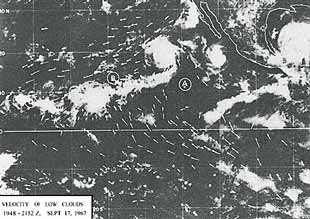
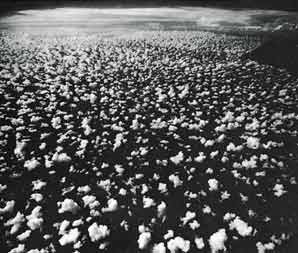
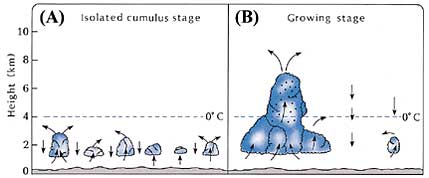
No comments:
Post a Comment